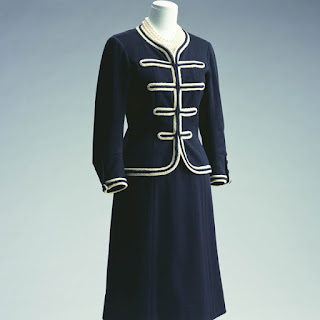Although Coco Chanel was a well established couturier by the 1950's, her influence on the styles and fashions from that era cannot be discounted.
Born Gabrielle Bonheur on August 19, 1883, she and her sister were sent to a French orphanage by her father after her mother died. With guidance from the nuns, she honed her dressmaking and designing skills into a craft that would become her lifelong occupation.
Early Years
She left the orphanage when she was eighteen and took the stage name Coco during her brief stint as a singer. She said it was a shortened version of cocotte, a french word for "kept woman."
Her first fashion venture was as a milliner in Paris when she opened her first shop in 1910. In 1913, she opened a boutique in Deauville, France and designed a slim and simple long sleeved black jersey dress.
Although other early to mid 1920's designers had fashioned looser fitting dresses made to be worn without the early 1900's corset restrictions, it was Coco Chanel who has been universally credited with The Little Black Dress dress. She would later be quoted as saying, "My fortune is built on that old jersey that I'd put on because it was cold in Deauville."
Chanel accepted Samuel Goldwyn's offer to design costumes for his MGM stars, she blatantly expressed her dislike for the movie making business and Hollywood in general. Her designs did not live up to the glamour of the 1930's era and the venture failed.
Paris
After much evidence was introduced alleging her pro-Nazi sympathies during World War II, Coco retreated to Switzerland in 1945, where she remained until the opening of her Paris Couture House in 1954.
Parisians shunned her designs while the British and American clients became her most loyal fifties fashion fans.
Upon reopening her design house following WWII, she combined the hour glass silhouette popular during the fifties era with the equally popular tiers of ruffles. Her evening gowns were designed with heavy boning and net covered bodices which needed no undergarments.
But it was the cropped jacket paired with a straight skirt that became Chanel's trademark. It was a signature look that was completed with her costume jewelry and the ever popular Chanel No. 5 perfume.
The Chanel Look has endured for decades reminding us of Coco's still relevant quote, "Fashion changes, but style endures."
 |
| 1930 Vogue UK Coco Chanel Illustration |
Early Years
She left the orphanage when she was eighteen and took the stage name Coco during her brief stint as a singer. She said it was a shortened version of cocotte, a french word for "kept woman."
Her first fashion venture was as a milliner in Paris when she opened her first shop in 1910. In 1913, she opened a boutique in Deauville, France and designed a slim and simple long sleeved black jersey dress.
Although other early to mid 1920's designers had fashioned looser fitting dresses made to be worn without the early 1900's corset restrictions, it was Coco Chanel who has been universally credited with The Little Black Dress dress. She would later be quoted as saying, "My fortune is built on that old jersey that I'd put on because it was cold in Deauville."
 |
Chanel Crepe Chiffon Evening Gown 1925
|
Paris
After much evidence was introduced alleging her pro-Nazi sympathies during World War II, Coco retreated to Switzerland in 1945, where she remained until the opening of her Paris Couture House in 1954.
 |
| Chanel No. 5 Courtesy of Austin Calhoun |
Upon reopening her design house following WWII, she combined the hour glass silhouette popular during the fifties era with the equally popular tiers of ruffles. Her evening gowns were designed with heavy boning and net covered bodices which needed no undergarments.
 |
| Chanel Suit Autumn/Winter 1956 ©Kyoto Costume Institute Photo by Takashi Hatakeyama Gift of Fashion Institute of Technology |
The Chanel Look has endured for decades reminding us of Coco's still relevant quote, "Fashion changes, but style endures."

No comments:
Post a Comment